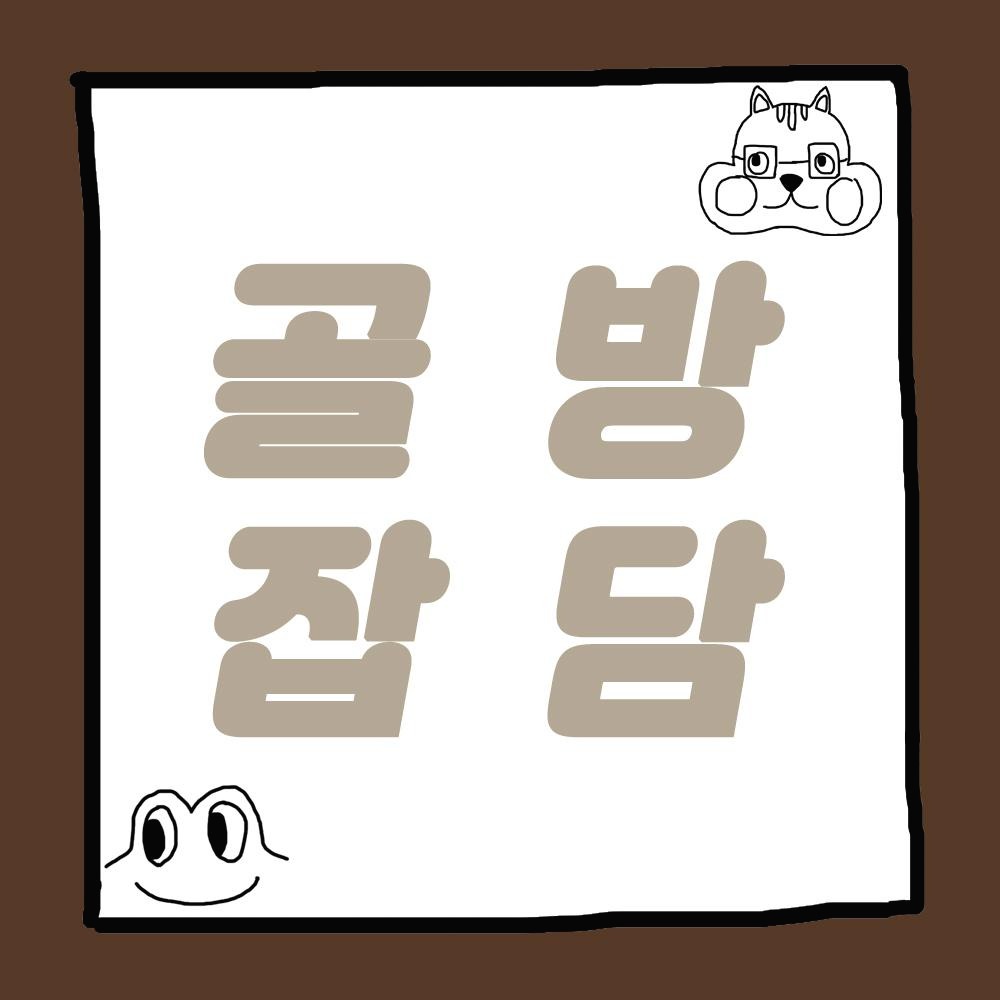골방잡담
한국인이 사랑하는 대표 음식 40가지 본문
한국 음식의 정체성과 자부심
한국에는 무려 100가지 이상의 김치가 있을 정도로, 음식에 대한 자부심이 깊습니다.
문화적 변화 속에서도 음식은 여전히 한국인의 정체성을 구성하는 핵심 요소입니다.
CNN은 한국인의 마음과 위장을 사로잡은 음식 40가지를 선정했습니다.
South Korea's best dishes 1 of 22 courtesy Korean Tourism Organization

Bibimbap: This Korean lunch-in-a-bowl mixes together a simple salad of rice, mixed vegetables, rice, beef and egg, with sesame oil and a dollop of chili paste for seasoning.

Samgyetang: Samgyetang is a thick, glutinous soup with a whole chicken stuffed with ginseng. The cooking process tones down the ginseng's signature bitterness and leaves an oddly appealing, aromatic flavor in its stead.

Samgyeopsal: Served with lettuce, perilla leaves, sliced onions and raw garlic kimchi, the sizzling pork strips are smudged in ssamjang (a mix of soybean paste called 'doenjang' and chili paste called 'gochujang') or salt and pepper in sesame oil.

Sundae: Another street food staple, sundae is pig intestine with a stuffing of cellophane noodles, vegetables and meat.

Gimbap: For this one, sauteed vegetables, ground beef, sweet pickled radish and rice are rolled and tightly wrapped in a sheet of laver seaweed (gim), and then sliced into bite-sized circles.
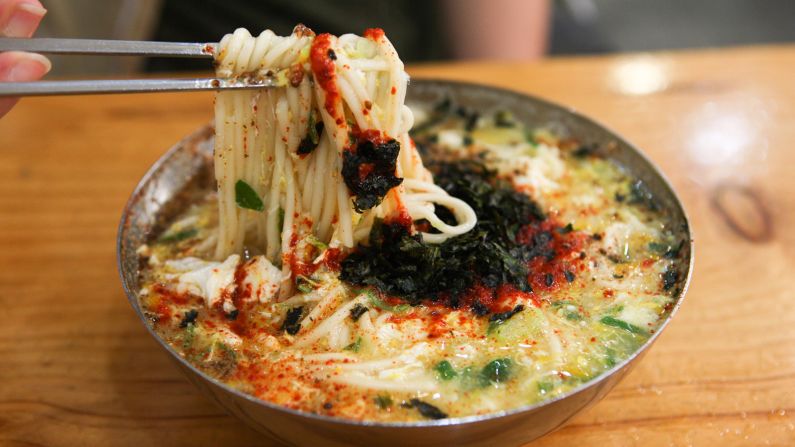
Kalguksu: Kalguksu, made with handmade knife noodles, is considered a summer dish, but it's served all year round.
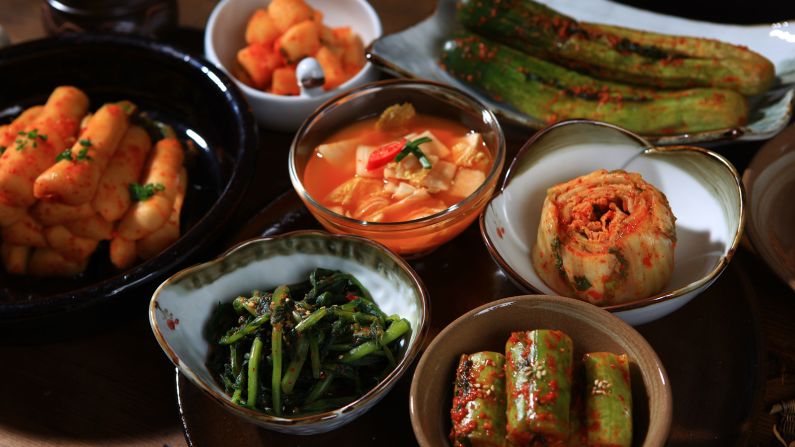
Kimchi: Dating to the Silla Dynasty (around 2,000 years ago), kimchi is the beloved spicy sidekick at every Korean table. It's made by salting and preserving fermented cabbage in a bed of red chili pepper, garlic, ginger and scallion.

Chuncheon dakgalbi: In this dish, chunks of chicken are marinated in a sauce of chili paste and other spices, and stir-fried in a large pan with tteok, cabbage, carrots and slices of sweet potato.

Bossam: The key to this dish is that the pork -- boiled or simmered -- is sliced into squares slightly larger than a bite, lovingly wrapped in a leaf of lettuce, perilla or kimchi, and daubed with a dipping sauce.

Soy sauce crab: Ganjang gejang, or raw crab marinated in soy sauce, can be so addictive that it's often affectionately called "rice thief," the joke being that you keep eating more rice just so that you can have more gejang since it's just that good.

Tteokbokki: This iconic red-orange street food is so popular there's an entire town in Seoul just devoted to the steamed and sliced rice cakes (tteok), cooked with fish cakes (oden) and scallions in a sweet and spicy sauce made of chili paste.
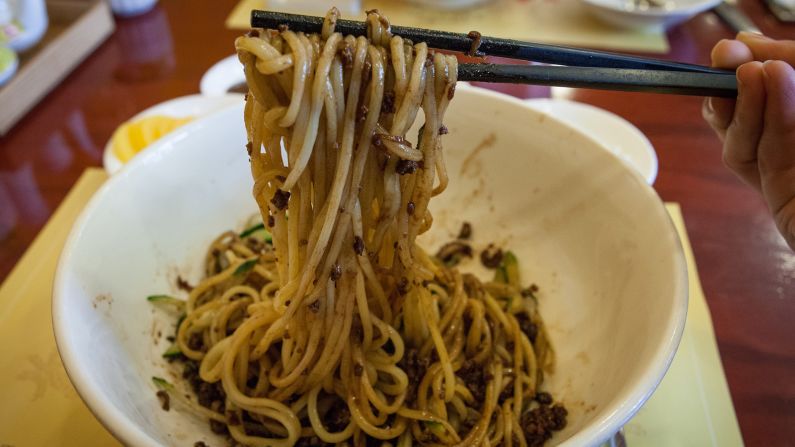
Jjajangmyeon: Although originally a Chinese dish, Koreans have taken the noodles and created a thicker, sweeter version that holds only a vague resemblance to its Chinese predecessor.

Jjambbong: This dish is the soupier, spicier counterpart to jjajangmyeon. Although noodles dominate in terms of sheer quantity, the onions and chili oil that flavor the soup are what really demand your attention.

Galbi: Galbi, which means "rib," can technically come from pork and even chicken, but when you just say "galbi" sans modifiers, you're talking about thick slabs of meat marinated in a mixture of soy sauce, chopped garlic and sugar and grilled over a proper fire.

Army Stew: This hodgepodge stew of sausages, Spam, American cheese, instant noodles, tteok and assorted vegetables dates back to the aftermath of the Korean War.
Because meat was scarce, cooks found creative replacements in the surplus foods from the American army base in Seoul, hence the stew's name.
Because meat was scarce, cooks found creative replacements in the surplus foods from the American army base in Seoul, hence the stew's name.
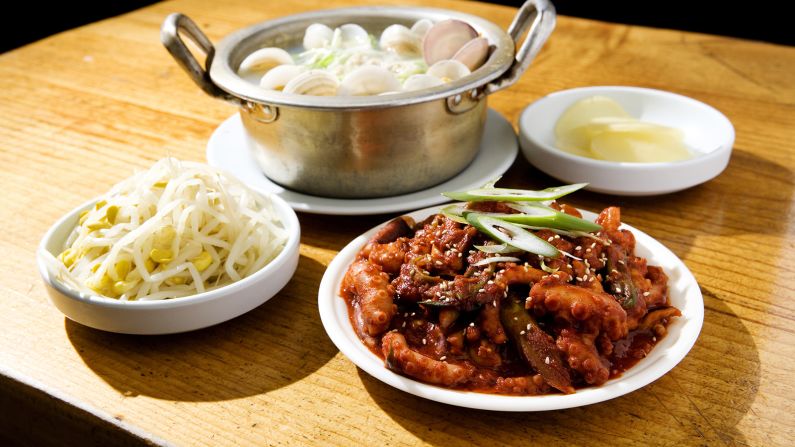
Nakji bokkeum: In this enduring favorite, octopus is stir-fried with vegetables in a sauce of chili paste, chili powder, green peppers and chili peppers -- ingredients that would be spicy enough on their own, but which all congregate to create one extra fiery dish.

Mudfish Soup: The selling point of this soup is the coarse yet satisfying texture of the mudfish and the vegetables -- mung bean sprouts, dried radish greens, sweet potato stems and most of all the thin, delicate outer cabbage leaves.

Bulgogi: This well-known sweet meat dish, which has existed in some form for over a thousand years, was haute cuisine during the Joseon Dynasty.

Dotorimuk: This light brown jello, made of acorn starch, is served cold, frequently with a topping of chopped leeks and soy sauce as a side dish, or as an ingredient in Dotorimuk salads and dotorimukbap (dotorimuk with rice).
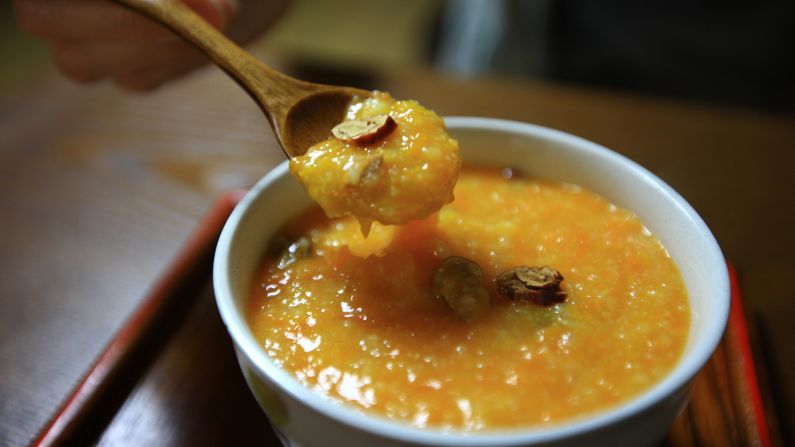
Hobakjuk: This viscous, yellow-orange juk, or porridge, gets its distinctive color and flavor from the pumpkin, its namesake and its main ingredient. The pumpkin is peeled, boiled, and blended with glutinous rice flour, and the result is a bowl of porridge so creamy, golden and sweet that in some ways it seems more pudding than porridge.

Tteokguk (떡국): Originally tteokguk was strictly eaten on the first day of the Lunar New Year to signify good luck and the gaining of another year in age. But this dish of oval rice cake slices, egg, dried laver seaweed and occasionally dumplings in a meat-based broth is now eaten all year round, regardless of age or season.
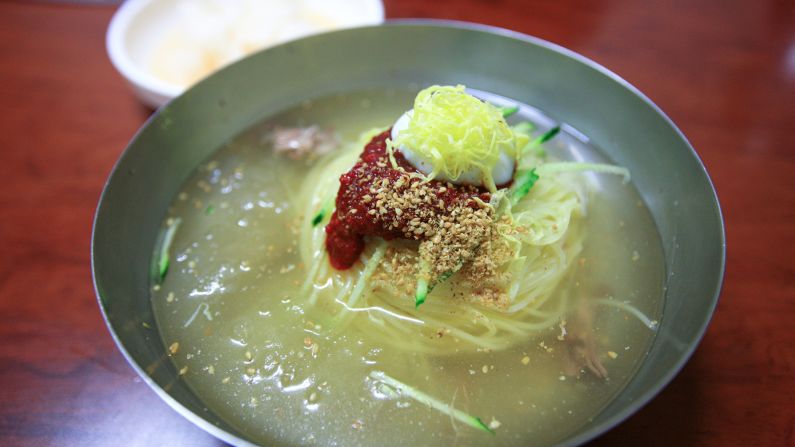
Naengmyeon: The cold buckwheat noodles are great as a lightweight lunch option or after Korean barbecue, as a way to cleanse the palate.
명절과 일상 사이
- 떡국: 원래는 설날에만 먹었지만 지금은 계절과 나이에 상관없이 즐기는 음식.
- 삼계탕: 더운 여름, 더운 국물로 더위를 이긴다는 ‘이열치열’ 대표 음식.
- 호박죽: 부드럽고 달콤한 건강식.
- 계란찜: 매운 음식과 함께 반드시 곁들이는 부드러운 사이드.
거리의 맛, 국민 간식
- 떡볶이: 서울에 떡볶이만 파는 거리도 있을 정도로 국민 간식.
- 순대: 당면, 채소, 고기를 돼지 창자에 채운 전통 길거리 음식.
- 뻥튀기: 소리로 이름 붙여진 전통 간식.
- 치맥: 치킨과 맥주, 이제는 단순한 조합을 넘어 하나의 문화.
국수, 국물, 그리고 해장
- 냉면: 여름이면 무조건 찾게 되는 대표 냉면.
- 콩국수: 채식주의자에게도 좋은 고소하고 담백한 여름 별미.
- 칼국수: 담백함이 핵심인 수제 국수 요리.
- 설렁탕: 간단하지만 깊은 맛의 겨울 대표 보양식.
- 해장국: 술 문화만큼 발달한 해장 음식 문화의 핵심.
- 감자탕: 뼈해장국이라고도 불리며, 늦은 밤이나 새벽에 인기.
- 추어탕: 미꾸라지를 곱게 갈아 만든 깊은 맛의 탕.
고기, 구이, 그리고 불맛
- 삼겹살: 한국식 바비큐의 상징.
- 갈비: 불에 구운 갈비는 한국식 육류 요리의 중심.
- 불고기: 조선시대부터 전해져 온 달콤한 고기 요리.
- 곱창: 쫄깃한 식감과 흥겨운 분위기로 사랑받는 술안주.
- 보쌈: 쌈과 함께 먹는 찐 고기의 진수.
해물의 풍미
- 간장게장: ‘밥도둑’이라 불릴 정도로 중독성 있는 음식.
- 해물파전: 비 오는 날 막걸리와 최고의 궁합.
- 물회: 회, 고추장, 육수가 어우러진 매콤달콤 여름 별미.
- 아구찜: 매운 양념 속 부드러운 아귀살과 숙주가 조화를 이루는 음식.
- 낙지볶음: 매운맛 애호가들을 위한 강렬한 해물 볶음.
퓨전과 대중화
- 비빔밥: 왕이 먹던 음식에서 국민 점심으로.
- 김밥: 너무 예뻐서 먹기 아까울 정도로 정갈한 한 끼.
- 잡채: 잔칫상과 모임에서 빠지지 않는 대표 면요리.
- 짜장면: 한국식으로 변형된 중국 요리.
- 짬뽕: 짜장면의 매운 버전, 얼큰한 국물이 포인트.
- 부대찌개: 한국 전쟁 이후 미군 부대 식자재에서 탄생한 퓨전 스튜.
- 라면: 한국인의 창의력을 반영하는 국민 인스턴트 식품.
- 된장찌개: 가장 기본이지만 가장 오래 사랑받는 찌개.
독특한 식재료와 건강식
- 도토리묵: 도토리 전분으로 만든 쌉쌀한 맛의 묵.
- 순두부찌개: 부드러운 두부와 해산물이 어우러진 매운 찌개.
- 두부김치: 삶은 두부에 볶은 김치와 고기를 곁들인 안주.
이 40가지 한국 음식은 단순한 요리를 넘어 한국인의 정체성, 역사, 그리고 삶의 방식을 담고 있습니다.
세계 어느 나라에서도 쉽게 찾아볼 수 없는 한국만의 음식 문화는 앞으로도 계속 진화하며 세계인들의 입맛을 사로잡을 것입니다.
'뒷방에서 CNN BBC > 영화 드라마 스타 한류' 카테고리의 다른 글
| 뉴욕타임스 선정 21세기 최고의 영화 100편: 장르와 경계를 허물다 (1) | 2025.06.28 |
|---|---|
| 한국계 작가 김주혜, 세계 문학계에 또 하나의 감동을 선사하다 (2) | 2025.06.19 |
| 길상사와 법정스님 이야기 : 무소유를 실천한 사람들 (4) | 2025.06.14 |
| 픽사 클래식 '소울(Soul)' 의 잔잔한 이야기 (3) | 2025.06.14 |
| 파리바게뜨, 프랑스풍으로 세계로 뻗어가는 한국 베이커리 (2) | 2025.06.12 |
Comments
